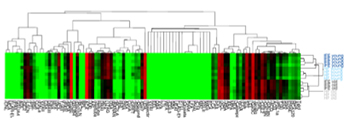Research News
Skin Stem Cells Shuffle Sugars as They Age
Researchers from the University of Tsukuba show that a 'glycome shift' in epidermal stem cells, a change in their repertoire of complex sugars, may be a potential biomarker of aging
Tsukuba, Japan—Age shows nowhere better than on the skin. The ravages of time on skin and the epidermal stem cells that differentiate to replenish its outer layer have been hypothesized, but there has been no method to evaluate their aging at the molecular level. Now, researchers at the University of Tsukuba and the National Institute of Advanced Industrial Science and Technology (AIST) have revealed that changes in the complex sugars called glycans that coat the surface of epidermal stem cells can serve as a potential biological marker of aging.
Skin is the largest human organ and a vital barrier against infection and fluid loss. Aging impairs environmental defenses and wound healing, while increasing hair loss and cancer risk. A key process underlying epidermal function in health and disease is cellular glycosylation that mediates cell-cell interactions and cell-matrix adhesions. Glycosylation involves attaching glycans to proteins; the profile of all glycans on and in a cell—collectively 'the cell glycome'—could reflect its functional scope and serve as an index of its age.
The researchers first isolated epidermal stem cells from the skin of young and old laboratory mice, including both hair follicle cells and interfollicular epidermal cells. These cells underwent glycan profiling using the lectin microarray platform; this technique uses lectins—proteins that bind specific glycans—and enables glycome analysis even for cells sparsely dispersed in tissues.
"Our results clearly showed that high mannose-type N-glycans are replaced by a2-3/6 sialylated complex type N-glycans in older epidermal stem cells," senior author, Professor Hiromi Yanagisawa, explains. "We followed this with gene expression analysis; this revealed up-regulation of a glycosylation-related mannosidase and two sialyltransferase genes, suggesting that this 'glycome shift' may be mediated by age-modulated glycosyltransferase and glycosidase expression."
Finally, to check whether the glycan changes were the cause or merely the result of aging, the research team overexpressed the up-regulated glycogenes in primary epidermal mouse keratinocytes in vitro. The keratinocytes showed decreased mannose and increased Sia modifications, replicating the in vivo glycosylation pattern of aging epidermal stem cells. In addition, their decreased ability to proliferate suggested that these alterations may reflect the waning ability of aging epidermal stem cells to proliferate.
Professor Aiko Sada, currently Principal Investigator at Kumamoto University, and Professor Hiroaki Tateno at AIST, co-corresponding authors, explain the implications of their results. "Our work is broadly targeted at investigating stem cell dysfunction specifically in aging skin. Future advances may help manage skin disorders at the stem cell level, including age-related degenerative changes, impaired wound healing and cancer."

Original Paper
The article, "Glycome profiling by lectin microarray reveals dynamic glycan alterations during epidermal stem cell aging" was published inAging Cell at DOI: 10.1111/acel.13190


